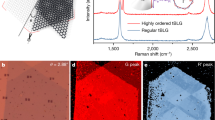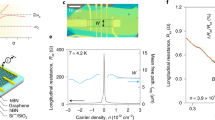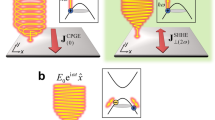Abstract
When a physical system is governed by statistical or dynamical equations possessing certain symmetries, its stationary states can be classified into phases according to which of those symmetries are preserved, and which are broken1,2. Near equilibrium, the properties of the system’s collective excitations reflect the symmetries of the underlying phase and thereby provide means for detecting these phases3,4. Here, we show that, in driven systems, the collective modes may take on a separate life, exhibiting their own spontaneous symmetry-breaking phenomena independent of the underlying equilibrium phase. We illustrate this principle by demonstrating a mechanism through which a non-magnetic interacting metal subjected to a linearly polarized driving field can spontaneously magnetize. The strong internal a.c. fields of the metal driven close to its plasmonic resonance5,6 enable Berryogenesis: the spontaneous generation of a self-induced Bloch band Berry flux. The self-induced Berry flux supports and is sustained by a chiral circulating plasmonic motion that breaks the mirror symmetry of the system. This non-equilibrium phase transition may be of either continuous or discontinuous type. Berryogenesis can occur in a wide variety of multiband metals with high-quality plasmons, as available in present-day graphene devices7,8,9.
This is a preview of subscription content, access via your institution
Access options
Access Nature and 54 other Nature Portfolio journals
Get Nature+, our best-value online-access subscription
$29.99 / 30 days
cancel any time
Subscribe to this journal
Receive 12 print issues and online access
$209.00 per year
only $17.42 per issue
Buy this article
- Purchase on Springer Link
- Instant access to full article PDF
Prices may be subject to local taxes which are calculated during checkout



Similar content being viewed by others
Data availability
The data that support the plots within this paper and other findings of this study are available from the corresponding authors upon reasonable request.
References
Chaikin, P. M. & Lubensky, T. C. Principles of Condensed Matter Physics (Cambridge University Press, 1995).
Haken, H. Cooperative phenomena in systems far from thermal equilibrium and in nonphysical systems. Rev. Mod. Phys. 47, 67–121 (1975).
Goldstone, J., Salam, A. & Weinberg, S. Broken symmetries. Phys. Rev. 127, 965–970 (1962).
Basov, D. N., Fogler, M. M. & García de Abajo, F. J. Polaritons in van der Waals materials. Science 354, aag1992 (2016).
Atwater, H. A. & Polman, A. Plasmonics for improved photovoltaic devices. Nat. Mater. 9, 205–213 (2010).
Koppens, F. H. L., Chang, D. E. & Garcia de Abajo, F. J. Graphene plasmonics: a platform for strong light–matter interactions. Nano Lett. 11, 3370–3377 (2011).
Woessner, A. et al. Highly confined low-loss plasmons in graphene-boron nitride heterostructures. Nat. Mater. 14, 421–425 (2015).
Ni, G. X. et al. Fundamental limits to graphene plasmonics. Nature 557, 530–533 (2018).
Iranzo, D. A. et al. Probing the ultimate plasmon confinement limits with a van der Waals heterostructure. Science 360, 291–295 (2018).
Yao, W., MacDonald, A. H. & Niu, Q. Optical control of topological quantum transport in semiconductors. Phys. Rev. Lett. 99, 047401 (2007).
Sie, E. J. et al. Valley-selective optical Stark effect in monolayer WS2. Nat. Mater. 14, 290–294 (2015).
Basov, D. N., Averitt, R. D. & Hsieh, D. Towards properties on demand in quantum materials. Nat. Mater. 16, 1077–1088 (2017).
Fausti, D. et al. Light-induced superconductivity in a stripe-ordered cuprate. Science 331, 189–191 (2011).
Wang, Y. H., Steinberg, H., Jarillo-Herrero, P. & Gedik, N. Observation of Floquet–Bloch states on the surface of a topological insulator. Science 342, 453–457 (2013).
Oka, T. & Aoki, H. Photovoltaic Hall effect in graphene. Phys. Rev. B 79, 081406 (2009).
Kitagawa, T., Berg, E., Rudner, M. & Demler, E. Topological characterization of periodically driven quantum systems. Phys. Rev. B 82, 235114 (2010).
Kitagawa, T., Oka, T., Brataas, A., Fu, L. & Demler, E. Transport properties of nonequilibrium systems under the application of light: photoinduced quantum Hall insulators without Landau levels. Phys. Rev. B 84, 235108 (2011).
Lindner, N. H., Refael, G. & Galitski, V. Floquet topological insulator in semiconductor quantum wells. Nat. Phys. 7, 490–495 (2011).
Gu, Z., Fertig, H. A., Arovas, D. P. & Auerbach, A. Floquet spectrum and transport through an irradiated graphene ribbon. Phys. Rev. Lett. 107, 216601 (2011).
Usaj, G., Perez-Piskunow, P. M., Foa Torres, L. E. F. & Balseiro, C. A. Irradiated graphene as a tunable Floquet topological insulator. Phys. Rev. B 90, 115423 (2014).
Yudin, D., Eriksson, O. & Katsnelson, M. I. Dynamics of quasiparticles in graphene under intense circularly polarized light. Phys. Rev. B 91, 075419 (2015).
Grushin, A. G., Gómez-León, A. & Neupert, T. Floquet fractional Chern insulators. Phys. Rev. Lett. 112, 156801 (2014).
Sodemann, I. & Fu, L. Quantum nonlinear Hall effect induced by Berry curvature dipole in time-reversal invariant materials. Phys. Rev. Lett. 115, 216806 (2015).
You, J.-S., Fang, S., Xu, S.-Y., Kaxiras, E. & Low, T. Berry curvature dipole current in the transition metal dichalcogenides family. Phys. Rev. B 98, 121109(R) (2018).
Son, D. T. & Yamamoto, N. Berry curvature, triangle anomalies, and the chiral magnetic effect in Fermi liquids. Phys. Rev. Lett. 109, 181602 (2012).
Son, D. T. & Spivak, B. Z. Chiral anomaly and classical negative magnetoresistance of Weyl metals. Phys. Rev. B 88, 104412 (2013).
Song, J. C. W. & Rudner, M. S. Chiral plasmons without magnetic field. Proc. Natl Acad. Sci. USA 113, 4658–4663 (2016).
Dykman, M. I. & Krivoglaz, M. A. Fluctuations in nonlinear systems near bifurcations corresponding to the appearance of new stable states. Physica 104A, 480–494 (1980).
Dykman, M. I. Theory of optical polarization bistability. Sov. Phys. JETP 64, 927–933 (1986).
Vasyukov, D. et al. A scanning superconducting quantum interference device with single electron spin sensitivity. Nat. Nanotechnol. 8, 639–644 (2013).
Degen, C. L. Scanning magnetic field microscope with a diamond single-spin sensor. Appl. Phys. Lett. 92, 243111 (2008).
Xia, J., Beyersdorf, P. T., Fejer, M. M. & Kapitulnik, A. Modified Sagnac interferometer for high-sensitivity magneto-optic measurements at cryogenic temperatures. Appl. Phys. Lett. 89, 062508 (2006).
Foster, M. S., Gurarie, V., Dzero, M. & Yuzbashyan, E. A. Quench-induced Floquet topological p-wave superfluids. Phys. Rev. Lett. 113, 076403 (2014).
Alicea, J., Balents, L., Fisher, M. P. A., Paramekanti, A. & Radzihovsky, L. Transition to zero resistance in a two-dimensional electron gas driven with microwaves. Phys. Rev. B 71, 235322 (2005).
Shirley, J. H. Solution of the Schrödinger equation with a Hamiltonian periodic in time. Phys. Rev. 138, B979–B987 (1965).
Sambe, H. Steady states and quasienergies of a quantum mechanical system in an oscillating field. Phys. Rev. A 7, 2203–2213 (1973).
Haldane, F. D. M. Berry curvature on the Fermi surface: anomalous Hall effect as a topological Fermi-liquid property. Phys. Rev. Lett. 93, 206602 (2004).
Acknowledgements
We thank D. Huse, M. Kats, M. Katsnelson, L. Levitov, R. Nandkishore, L. Radzihovsky and G. Refael for helpful discussions. M.S.R. gratefully acknowledges the support of the European Research Council under the European Union Horizon 2020 Research and Innovation Programme (grant agreement no. 678862), and the Villum Foundation. J.C.W.S. gratefully acknowledges the support of the Singapore National Research Foundation (NRF) under NRF fellowship award NRF-NRFF2016-05, and a start-up grant from the Nanyang Technological University.
Author information
Authors and Affiliations
Contributions
M.S.R. and J.C.W.S. designed the research, performed the research and wrote the paper together.
Corresponding authors
Ethics declarations
Competing interests
The authors declare no competing interests.
Additional information
Publisher’s note: Springer Nature remains neutral with regard to jurisdictional claims in published maps and institutional affiliations.
Supplementary information
Supplementary Information
Additional theoretical details and refs. 1–15.
Rights and permissions
About this article
Cite this article
Rudner, M.S., Song, J.C.W. Self-induced Berry flux and spontaneous non-equilibrium magnetism. Nat. Phys. 15, 1017–1021 (2019). https://doi.org/10.1038/s41567-019-0578-5
Received:
Accepted:
Published:
Issue Date:
DOI: https://doi.org/10.1038/s41567-019-0578-5
This article is cited by
-
Strongly correlated electron–photon systems
Nature (2022)
-
Electronic Floquet gyro-liquid crystal
Nature Communications (2021)
-
Ultrafast and anharmonic Rabi oscillations between non-Bloch bands
Communications Physics (2020)
-
Band structure engineering and non-equilibrium dynamics in Floquet topological insulators
Nature Reviews Physics (2020)
-
A sudden twist
Nature Physics (2019)



